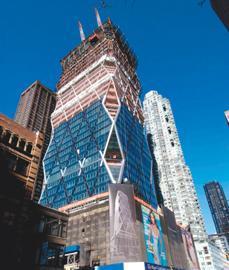ASHRAE showcased its good intentions on sustainability at its winter meeting held in Chicago on 21-25 January. Delegate Tim Dwyer reports on the highlights and possible seeds of change
There was no escaping the idea that ASHRAE would like to be the world leader in sustainable buildings design at the organisation's recent winter conference held in Chicago on 21-25 January. That was the message aired in all ways - from lapel pins, to keynote speeches.
At times it seemed a bit like ‘Two Jags Prescott' evangelising about the benefits of bio-fuelled Minis. Nevertheless, beyond the hype there was evidence of action as well as words - because ASHRAE is now putting money behind the message.
The first seminar, ‘ASHRAE HQ extreme makeover', showed a resolve to lead by example. The organisation's existing headquarters building in Atlanta was laid bare to ruthless analysis during this presentation, including a LEED EB assessment (Leadership in Energy and Environmental Design - Existing Buildings, see www.usgbc.org/LEED/). The analysis showed the building was unsustainable in just about every way. Extensive occupant surveys, undertaken using web-based survey tools, also did little to redeem the building.
The new UK SBEM (or Simplified Building Energy Model; see www.ncm.bre.co.uk/index.jsp) was employed by Matt Collin of Arup to reveal a performance well below that required to meet the new UK regulations.
This seminar was timely, given that the ASHRAE board also voted during the meeting on first-stage funding for a major sustainability makeover of the HQ.
Throughout the four days of the meeting, sustainability proved to be a continuous strand in presentations. The first symposium of the meeting, ‘How low can you go - Low energy buildings through integrated design', included some excellent case studies.
Among the low-energy buildings featured were a small house that requires only 50p a day to cover energy use; a naturally ventilated building assessment (Houghton Hall, Luton; a similar report is available by visiting http://architecture.mit.edu and then doing a search for Houghton Hall); and the simple, but successful, Zion National Park visitor centre. The centre is suited to diurnal extremes of between 60°C and 15°C, while also having extremely low energy requirements and a much reduced build cost (see www.highperformancebuildings.gov/zion/).
Inevitably there are many more drivers than just environmental benefit when a development is commissioned. To account for all these potentially conflicting issues, Jitendra Singh outlined a potential framework to measure their value in his presentation ‘Green design and sustainability - Undefinable success in a defined world'. A number of forums also took place, during which open (and sometimes unreportable!) debate took place. One was entitled ‘I never promised you a rose garden - Building performance expectations and contract compliance', and invited participants to voice opinion on the sometimes incongruous worlds of the designer of sustainable buildings and the building operator.
There is undoubtedly much work to be done. In his presentation, Dick Hayter reported that half of all US homes have air conditioning and 81% of new homes have central air conditioning!
Despite taking place in the final sessions of the meeting, ‘The energy design process for high performance buildings' attracted a capacity audience and lively questioning (read it yourself at www.engg.ksu.edu/people/rhayter/HighPerformanceBuildings.ppt). Perhaps the high attendance was evidence of the growing enthusiasm for applying the right techniques to fulfil ASHRAE's draft strategic plan, titled ‘ASHRAE lead the advancement of sustainable building design and operations'.
The meeting also provided an opportunity for CIBSE and ASHRAE to agree a joint statement on climate change (see page 71 for a full report).
In his lunch address, ASHRAE president Lee Burgett quoted the Hebrew proverb: "As the gardener, such is the garden." He also spoke of the "gardeners of ASHRAE" who are working together "to grow a beautiful sustainable garden of HVAC&R technology". His hope was that the momentum of the meeting would be maintained by CIBSE and ASHRAE members once the event was over.
Source
Building Sustainable Design
Postscript
Tim Dwyer is a senior lecturer at London South Bank University and chair of the CIBSE ASHRAE Group























No comments yet